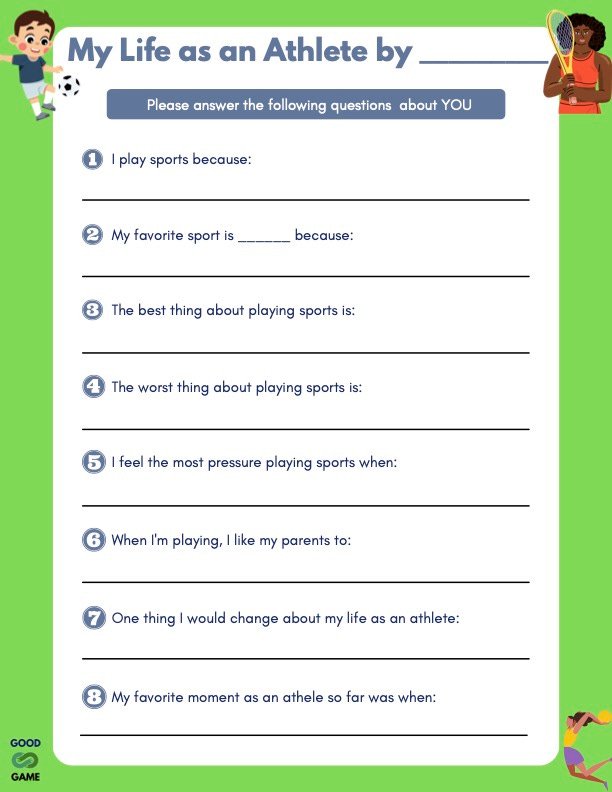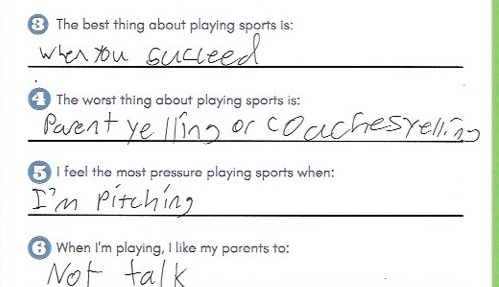This One's For the Kids
Do you REALLY know how your kid feels about their life as an athlete? We're here to help you find out.
Ohhh, I’m extra excited for today’s post because I think it might be our most important one yet.
None of us Good Gamers are in the exact same situation. Our kids are different ages, play a variety of sports, compete at different levels, and have different expectations. But the one commonality we share is that we love our kids and want to help them thrive in youth sports and beyond. Easier said than done. The love them part is easy, even after your fifteenth attempt to get your child to turn off YouTube videos of randos playing Minecraft has failed and your vocal cords are on fire from all the screaming. (That’s just an example, though, and definitely not something that happened in my house last night.)

The helping them navigate part is much trickier for a multitude of reasons. Personally, I get wrapped up with the constant decision making. Should we cut back on a sport? Is this fill-in-the-blank youth sports item going to be helpful or just another money grab? Is he doing enough outside training? Did he ice his arm long enough? Is this hardcore basketball camp going to push him athletically or push him to cry? This analysis paralysis is unhealthy in large part because it too often doesn’t start with the most important consideration: What do our kids want, and how do they feel when playing sports?
This question has been on my mind a lot, especially after re-watching this powerful video from I Love to Watch You Play that features an array of kids expressing their wants and want nots from their parents.
Largely inspired by this notion of giving kids a voice, I created a simple and PRINTABLE questionnaire that may provide a useful glimpse into your kids’ psyche when it comes to sports:
I really recommend you print out and ask your kids to fill it out. (Please msg me if you need the questionnaire sent in another format.)
At the very least, it’s a good way to sneak in a little more writing. But maybe you’ll discover something new about your kids. I had both my kids fill it out yesterday and truly had no idea that one of my kids felt pressure on the mound or that he was so impacted by all the yelling from parents and coaches.
It doesn’t mean there is some magic troubleshooting but this does go a long way in understanding my kid a little more and helping him make decisions that vibe with his goals and sensitivities. Asking for this basic information means I’m also giving some level of power to my kids which is quite healthy for our overall relationship. The sports are for them, after all.
If you decide to share with your kids and want to share some of the revelations, by all means, go for it. Guessing there’s a ton of kid-driven insight that could benefit us all. But this ultimately is for you and your kid. I hope it’s useful.
Be back Friday with the roundup! For those interested in the nitty gritty of the newsletter biz, read on…
Last weekend, Elon Musk provided all Substack writers a valuable reminder that the word of mouth of our communities is our greatest commodity. Many of us have also leaned on our decent-sized Twitter followings to get the word out about our newsletters. While not as powerful as your recommendations, it’s a prime marketing tool for any modern independent journalist. (Apologies to any of my Twitter followers who have been subjected to incessant self-promotion.)
Well, a day after Substack announced the addition of Substack Notes, a new tool for Substack users to chat incorporating a couple of Twitter-like features, Elon lost his shit. He blocked the ability to pin Substack posts to our feeds. He blocked the ability for anyone on Twitter to like, share or comment on any Substack link. To top off the pettiness, Elon redirected any search that included the word “Substack” to “newsletters.” It was megalomania at its finest, and yeah, it scared the bejeezus out of someone like me that just recently launched. But a couple days later, Elon must have gotten a good night’s sleep or something because he came to his senses and removed the handcuffs.
Ironically, I was down in LA on Friday for a belated Passover seder and my fam decided to pregame in an escape room in Reseda (The Architect – highly recommend!). It was a last-minute plan, and the only available room was called Tesla’s Secret. With :17 seconds remaining and with the aid of several clues, we helped find the “timeline switch” created by famed mechanical engineer and inventor, Nikola Tesla, that would shift humankind to a thriving dimension. Weird to be helping Tesla advance the world when the person running the company named after him is trying to destroy it, at least the communication part.
That’s my long-winded way of saying thanks for being here and your endorsement of Good Game is our most valuable resource. I appreciate you all so much!





As a part time youth soccer coach, during the game we try to only communicate with clapping. It's tough! We can use half time to add in any tactical changes or discuss observations. Us adults even leave the team for 2 minutes alone so they can discuss things themselves, and in their own way. But the best learning experience for youth players is to solve soccer problems on their own. If a player feels down about a decision or mistake, after the game we prompt them to discuss what they could have done better, then tell them how lucky they are to have had that learning opportunity and that next time they will be better prepared. Great article!